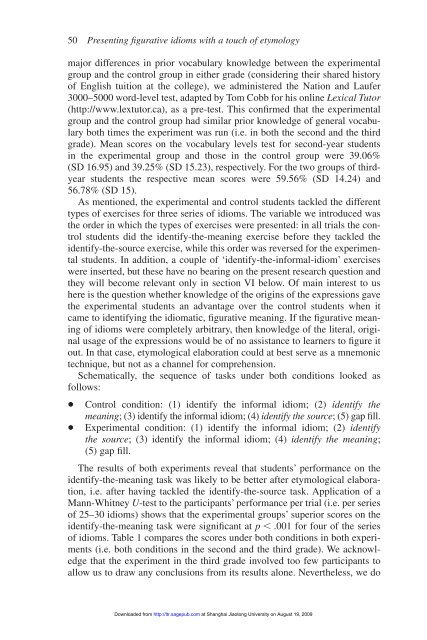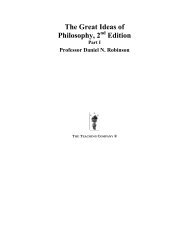Language Teaching Research
Language Teaching Research
Language Teaching Research
You also want an ePaper? Increase the reach of your titles
YUMPU automatically turns print PDFs into web optimized ePapers that Google loves.
50 Presenting figurative idioms with a touch of etymology<br />
major differences in prior vocabulary knowledge between the experimental<br />
group and the control group in either grade (considering their shared history<br />
of English tuition at the college), we administered the Nation and Laufer<br />
3000–5000 word-level test, adapted by Tom Cobb for his online Lexical Tutor<br />
(http://www.lextutor.ca), as a pre-test. This confirmed that the experimental<br />
group and the control group had similar prior knowledge of general vocabulary<br />
both times the experiment was run (i.e. in both the second and the third<br />
grade). Mean scores on the vocabulary levels test for second-year students<br />
in the experimental group and those in the control group were 39.06%<br />
(SD 16.95) and 39.25% (SD 15.23), respectively. For the two groups of thirdyear<br />
students the respective mean scores were 59.56% (SD 14.24) and<br />
56.78% (SD 15).<br />
As mentioned, the experimental and control students tackled the different<br />
types of exercises for three series of idioms. The variable we introduced was<br />
the order in which the types of exercises were presented: in all trials the control<br />
students did the identify-the-meaning exercise before they tackled the<br />
identify-the-source exercise, while this order was reversed for the experimental<br />
students. In addition, a couple of ‘identify-the-informal-idiom’ exercises<br />
were inserted, but these have no bearing on the present research question and<br />
they will become relevant only in section VI below. Of main interest to us<br />
here is the question whether knowledge of the origins of the expressions gave<br />
the experimental students an advantage over the control students when it<br />
came to identifying the idiomatic, figurative meaning. If the figurative meaning<br />
of idioms were completely arbitrary, then knowledge of the literal, original<br />
usage of the expressions would be of no assistance to learners to figure it<br />
out. In that case, etymological elaboration could at best serve as a mnemonic<br />
technique, but not as a channel for comprehension.<br />
Schematically, the sequence of tasks under both conditions looked as<br />
follows:<br />
• Control condition: (1) identify the informal idiom; (2) identify the<br />
meaning; (3) identify the informal idiom; (4) identify the source; (5) gap fill.<br />
• Experimental condition: (1) identify the informal idiom; (2) identify<br />
the source; (3) identify the informal idiom; (4) identify the meaning;<br />
(5) gap fill.<br />
The results of both experiments reveal that students’ performance on the<br />
identify-the-meaning task was likely to be better after etymological elaboration,<br />
i.e. after having tackled the identify-the-source task. Application of a<br />
Mann-Whitney U-test to the participants’ performance per trial (i.e. per series<br />
of 25–30 idioms) shows that the experimental groups’ superior scores on the<br />
identify-the-meaning task were significant at p .001 for four of the series<br />
of idioms. Table 1 compares the scores under both conditions in both experiments<br />
(i.e. both conditions in the second and the third grade). We acknowledge<br />
that the experiment in the third grade involved too few participants to<br />
allow us to draw any conclusions from its results alone. Nevertheless, we do<br />
Downloaded from<br />
http://ltr.sagepub.com at Shanghai Jiaotong University on August 19, 2009














